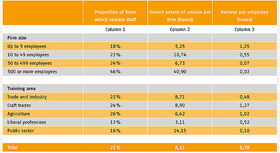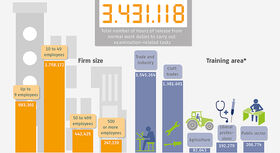The extent to which employees are released from work for examiner tasks
Felix Wenzelmann, Paula Risius
Intermediate and final examinations represent a major commitment for candidates, but examination board members must also devote considerable time to conducting them. This means that firms then need to release staff from their normal tasks. This article highlights the extent to which this happens and provides a breakdown of the firms making the greatest contribution in this regard. It also includes an estimate of costs incurred.
Composition of the examination board
The contribution firms make to the examination system extends beyond preparing trainees for the examinations themselves. The Vocational Training Act (BBiG) stipulates that both the employer and employee side should be involved in evaluating the examination performances which trainees are required to achieve. One of the outcomes of the 2020 reform of the BBiG was an amendment to the section of the law relating to the examination system.1 This change was made because various parties had raised the issue of the high time demands being placed on examiners. Very little empirical research has been conducted thus far into the extent to which employees are released from work duties in order to act as examiners. A survey of examiners commissioned by the Federal Ministry of Education and Research (BMBF) shows that employee representatives spent an average of 6.4 hours on examiner tasks in 2009. 2.8 hours of this took place in their free time. They were released from normal work duties by their employers for the remaining 3.6 hours (cf. BMBF 2011, p. 35).
BIBB survey measures the release of employees for examiner tasks
The current BIBB survey of costs and benefits of apprenticeship training (BIBB-CBS 2017/18, cf. Information Box) is the first to include two questions on the release of employees from work duties in order to carry out examiner tasks.2 These questions enable an evaluation to be made of the contribution made by firms towards the implementation of training examinations.
Database: BIBB Costs-Benefits Survey 2017/18 (BIBB-CBS 2017/18)
In BIBB’s sixth survey of costs and benefits of apprenticeship training, personal interviews were conducted with staff from firms providing training and with 996 firms which did not offer training in the 2017/18 training year. In the sample used, which was taken from the Federal Employment Agency firm database, firms providing training were significantly overrepresented following deliberate oversampling. The results of the survey can be extrapolated to the statistical population of firms via a weighting procedure and are thus representative of Germany (for more details cf. SCHÖNFELD/WENZELMANN et al. 2020).
Release from work duties for examiner tasks at 21 percent of firms providing training

A total of 21 percent of firms providing training3 stated that they had released employees to perform examiner tasks in one of the occupations in which they offer training4 during the 2017/18 training year. 18 percent of small firms with fewer than ten employees released staff. The corresponding figure for large firms with 500 employees or more was 46 percent. As far as areas of training are concerned, the liberal professions and the public sector lay below the overall average at 13 and 16 percent respectively. By way of contrast, the craft trades and agriculture were slightly above average in this regard (cf. Table p. 50, column 1).
Release period of over 3 million hours

If we extrapolate the release periods to all firms providing training and to the 2017/18 training year, we arrive at a total of 3.4 million hours (cf. Fig.). If examinations were to be conducted by examiners employed on a full-time basis, just over 2,000 persons would need to be recruited merely to be able to replace the examiners released from their work duties by the firms.5
The areas of trade and industry and the craft trades accounted for 1.5 million and just under 1.4 million hours respectively and thus made up the bulk of the total number. In 2017, just under 60 percent of trainees underwent training in trade and industry whilst the corresponding figure for the craft trades sector was 28 percent (cf. KROLL 2019). The majority of examinations thus took place in these areas. The outlay required in the craft trades sector per examination on the part of firm-based examiners therefore appears to be greater than that needed in trade and industry. One possible explanation for this is the higher effort of examination preparations and of practical examinations in the former case. In the training area of trade and industry, for example, there is an Examination Task and Teaching Material Development Agency (PAL) and a Task-Setting Body for Final and Intermediate Examinations in Commercial Occupations (AkA), which provide examination assignments and materials.
Firms with fewer than 50 employees contribute over 80 percent of all hours, although only 43 percent of trainees underwent training at firms in this size category in 2017 (cf. TROLTSCH 2019).
Assuming that employees released from their normal work duties always continue to be paid in full, the cost for the whole economy adds up to just under €80 million for the 2017/18 training year. This corresponds to about one percent of net training costs (€8.4 million)6, a figure that does not include the costs of releasing staff in this way.
Conclusion
This article uses a representative survey as a basis for supplying data regarding the effort incurred by firms for releasing employees from their normal work duties in order to carry out examiner tasks. This effort was previously unknown. Small firms and firms in the craft trades sector bear a disproportionately high share of the burdens. Participation in examinations is also a vehicle, which may produce positive impacts for the firm and its employees. Network effects or the transfer of knowledge between chambers, schools and other firms may, for example, occur. Empirical research still needs to be carried out as to whether the amendments made as part of the reform of the BBiG are leading to a reduction in release periods.
-
1
Existing data does not permit any assessment of the extent to which this is influencing the values presented here.
-
2
The questions posed were: “Did your firm release employees from their work duties in order to perform examiner tasks in the training occupation of (selected occupation) in the 2017/18 training year?” and “For how many hours in total were staff at your firm released from their normal work duties to carry out examiner tasks?” The formulation of the questions is unclear in respect of the meaning of the term “release”, since there is ambiguity as to whether this refers to time off which is paid or unpaid. If the latter circumstance applies, then employees will be bearing the actual costs by dint of the fact that they are giving up leisure time or wages.
-
3
Firms not providing training at the time of reference were not asked the questions about releasing staff. Particularly in the case of firms, which were temporarily not providing training, participation of staff in examinations is conceivable.
-
4
If a firm is providing training in more than one occupation, the occupation is stipulated at random at the start of the interview.
-
5
The figure of full-time employees hypothetically required was derived by dividing the 3.4 million hours by the average of 1,648 working hours which are performed annually by one person in full-time employment as indicated by the Institute for Employment Research (IAB) working time calculation for 2018 (for information of the methodology cf. WANGER/HARTL/ZIMMERT 2019). This means that downtimes caused by overtime, days of leave and further reasons are already taken into account.
-
6
cf. www.bibb.de/de/11060.php (status 08.12.2020)
Literature
BMBF: Gewinnung von ehrenamtlichen Prüfern in der Berufsbildung. Bonn/Berlin 2011
KROLL, S.: Gesamtbestand der Ausbildungsverhältnisse in der Berufsbildungsstatistik. In: BIBB (Ed.): Datenreport zum Berufsbildungsbericht 2019. Bonn 2019, pp. 108-117
SCHÖNFELD, G.; WENZELMANN, F. u.a.: Ausbildung in Deutschland – eine Investition gegen den Fachkräftemangel. Ergebnisse der BIBB-Kosten-Nutzen-Erhebung 2017/18. BIBB Report 1/2020
TROLTSCH, K.: Betriebliche Ausbildungsbeteiligung - Ergebnisse der Beschäftigungsstatistik der Bundesagentur für Arbeit. In: BIBB (Ed.): Datenreport zum Berufsbildungsbericht 2019. Bonn 2019, pp. 207-209. IAB-Forschungsbericht 7/2019. Nürnberg 2019
DR. FELIX WENZELMANN
Academic researcher at BIBB
PAULA RISIUS
Research consultant at the German Economic Institute, Cologne
Translation from the German original (published in BWP 4/2020): Martin Kelsey, GlobalSprachTeam, Berlin